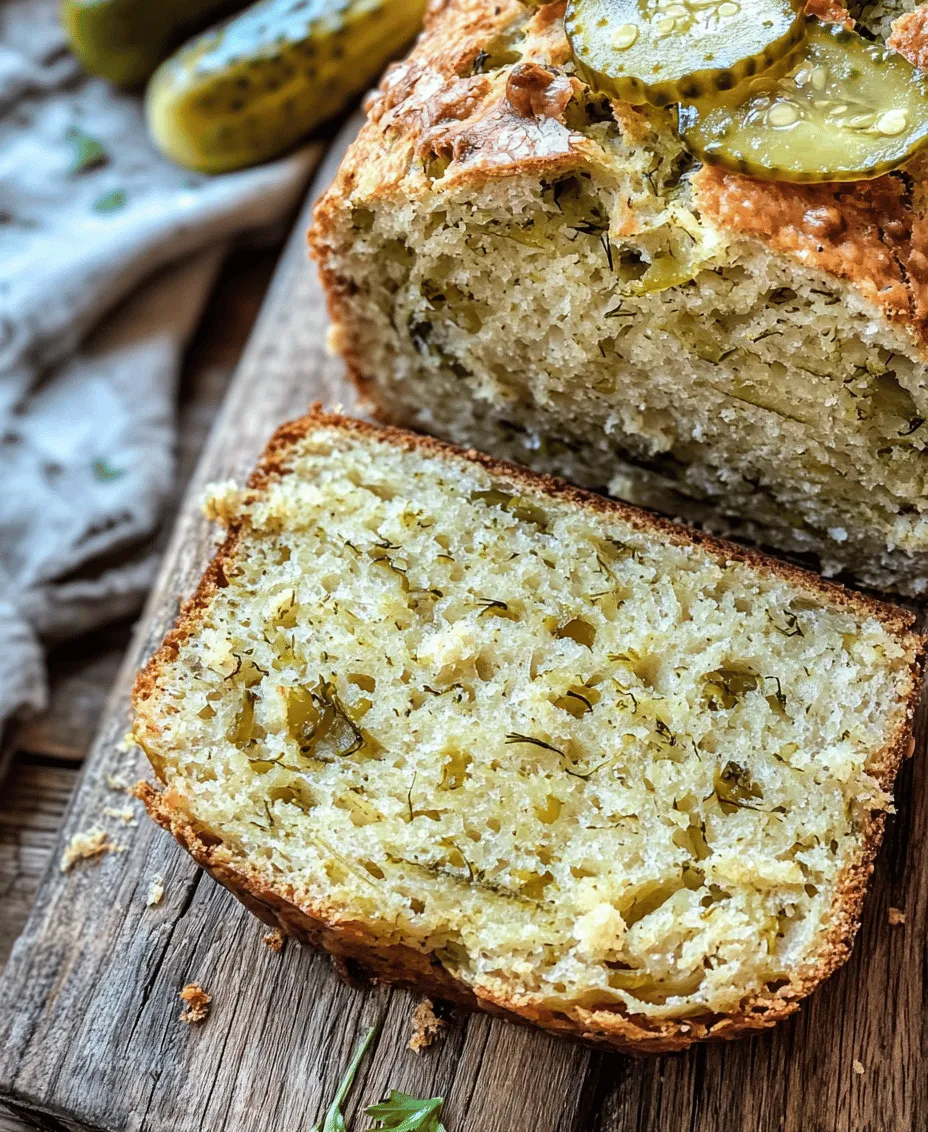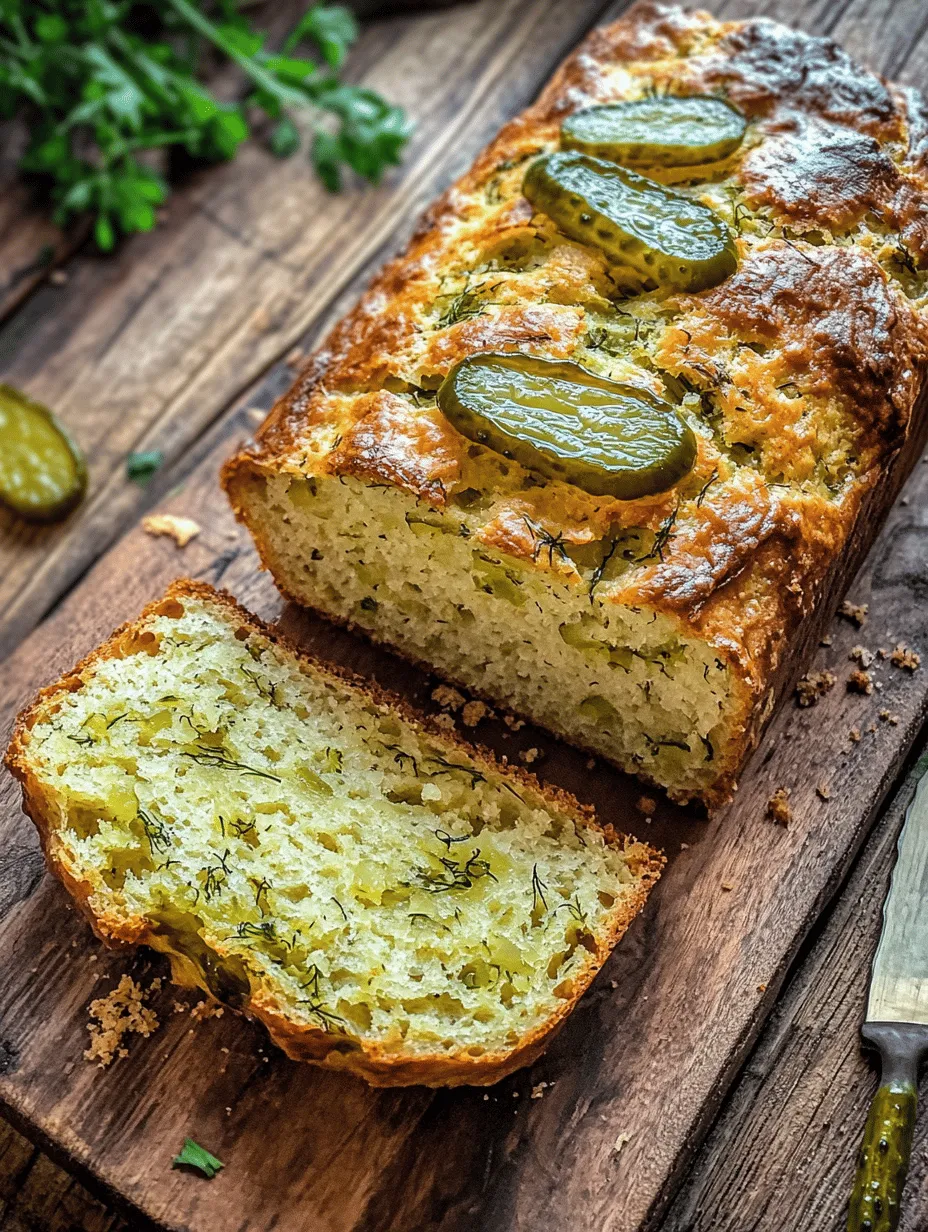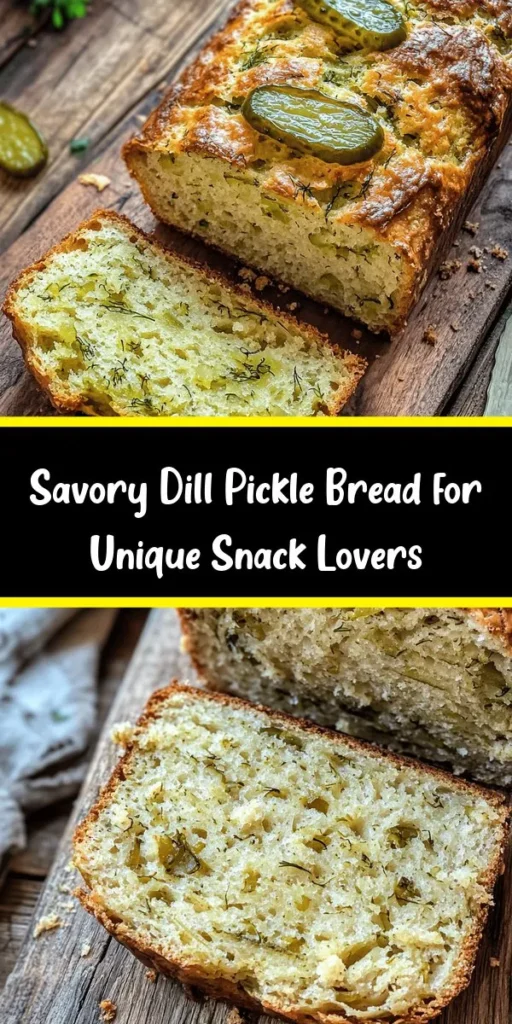Introduction
In recent years, the world of baking has seen a fascinating surge in unique and adventurous bread recipes that push the boundaries of traditional flavors. From sweet to savory, bakers are eager to experiment with unconventional ingredients, leading to delightful creations that surprise and satisfy. Among these innovative recipes is Dill Pickle Bread, a delightful twist that has captured the attention of food enthusiasts and home bakers alike.
Dill Pickle Bread stands out for its intriguing flavor profile, combining the tangy, briny essence of dill pickles with the comforting warmth of freshly baked bread. The result is a loaf that is not only delicious but also versatile—perfect for sandwiches, toast, or simply enjoyed on its own. Its unique taste appeals to both pickle lovers and those seeking new culinary experiences, making it a must-try for anyone looking to elevate their bread-baking game.
Understanding Dill Pickle Bread
So, what exactly is Dill Pickle Bread? This innovative recipe transforms the classic bread-making process by incorporating finely chopped dill pickles and pickle juice into the dough. The origins of this unique bread can be traced back to the growing trend of infusing baked goods with unexpected flavors. As culinary creativity flourishes, bakers have begun to embrace the idea that pickles—usually relegated to the side of a plate—can take center stage in a delicious loaf.
The key to Dill Pickle Bread’s distinctive charm lies in its unique ingredients. The addition of dill pickles and pickle juice not only enhances the flavor but also contributes moisture to the bread, resulting in a tender and moist crumb. This recipe is a wonderful example of how traditional baking techniques can be adapted to create something truly special, allowing the bright, tangy notes of dill to shine through in a new and exciting way.
Moreover, the culinary trend of incorporating pickles into baked goods is gaining traction, with various recipes popping up across food blogs and social media platforms. From pickle-flavored cupcakes to pickle-infused dips, the combination of sweet and sour flavors is resonating with many food lovers. Dill Pickle Bread is a delightful representation of this trend, showcasing how pickles can be transformed into a deliciously unexpected treat.
Ingredients Breakdown
Before diving into the preparation of this unique loaf, it’s essential to understand the role each ingredient plays in creating the perfect Dill Pickle Bread. Here’s a breakdown of the key ingredients:
– All-Purpose Flour: The foundation of the bread, all-purpose flour provides the necessary structure and body. Its versatility makes it an ideal choice for many baking recipes, allowing the bread to rise beautifully while maintaining a tender texture.
– Dill Pickles: The star ingredient of this recipe, dill pickles bring a bold and zesty flavor to the bread. Their unique taste, combined with the crunchiness of the diced pickles, adds a delightful contrast to the soft crumb of the loaf.
– Pickle Juice: This ingredient not only enhances the pickle flavor in the bread but also adds acidity, which helps balance out the richness of other ingredients. The moisture from the pickle juice contributes to a soft, tender loaf that won’t dry out.
– Granulated Sugar: While it may seem counterintuitive to add sugar to a savory bread, granulated sugar serves to balance the sourness of the pickles. This subtle sweetness rounds out the flavors and enhances the overall taste profile of the bread.
– Unsalted Butter: Adding richness and moisture, unsalted butter also helps to create a tender crumb. It enriches the flavor of the bread, contributing to that homemade taste we all love.
– Eggs: Eggs are crucial for providing structure and stability in baked goods. They also contribute to the bread’s overall texture, helping to create a light and fluffy loaf.
– Baking Powder and Baking Soda: These leavening agents work together to help the bread rise. Baking powder provides an extra lift, while baking soda helps neutralize the acidity from the pickle juice, ensuring a balanced flavor.
– Salt: A key player in any bread recipe, salt enhances the overall flavor and helps to control the fermentation process. It brings out the best in the other ingredients, making the bread more enjoyable to eat.
– Dried Dill Weed and Black Pepper: These complementary flavors elevate the bread, adding an extra layer of depth to the overall taste. Dried dill weed reinforces the pickle flavor and adds a fragrant aroma, while black pepper provides a subtle kick that enhances the tangy notes.
Preparation Steps
Now that we have a good understanding of the ingredients and their roles, let’s dive into the preparation of Dill Pickle Bread. Follow these steps to create your own delicious loaf:
1. Gather Your Ingredients: Start by assembling all the ingredients listed above. Having everything pre-measured and ready to go will streamline the baking process and ensure you don’t miss anything.
2. Preheat the Oven: Set your oven to 350°F (175°C) to ensure it is properly heated by the time your dough is ready for baking.
3. Prepare the Pickles: Chop the dill pickles into small, bite-sized pieces. For a smoother texture, you can pulse them in a food processor but be careful not to puree them; you want some chunks for texture.
4. Mix Dry Ingredients: In a large mixing bowl, whisk together the all-purpose flour, granulated sugar, baking powder, baking soda, salt, dried dill weed, and black pepper. Mixing the dry ingredients first ensures that the leavening agents are evenly distributed throughout the flour.
5. Combine Wet Ingredients: In a separate bowl, beat the eggs, and then add the unsalted butter (melted), pickle juice, and any remaining liquid from the chopped pickles. Whisk until well combined.
6. Combine Dry and Wet Mixtures: Pour the wet mixture into the bowl with the dry ingredients. Gently fold the mixture together using a rubber spatula until just combined. Be careful not to overmix, as this can lead to a dense loaf.
7. Fold in the Pickles: Once the dough is mostly combined, add the chopped dill pickles and fold them into the dough until evenly distributed. The pickles should be scattered throughout the batter, providing flavor and texture in every bite.
8. Prepare the Baking Pan: Grease a standard loaf pan with butter or cooking spray to prevent the bread from sticking. You can also line the pan with parchment paper for easier removal.
9. Transfer the Dough: Carefully spoon the dough into the prepared loaf pan, smoothing the top with the spatula. Make sure to spread it evenly to ensure uniform baking.
10. Bake the Bread: Place the loaf pan in the preheated oven and bake for approximately 50-60 minutes, or until the top is golden brown and a toothpick inserted into the center comes out clean.
As the bread bakes, your kitchen will fill with the enticing aroma of dill and freshly baked bread, setting the stage for a delightful culinary experience.
Stay tuned for the next part of this article, where we will cover additional tips for achieving the perfect Dill Pickle Bread and answer some common questions related to this unique recipe.

Preheat the Oven
Before diving into the intricacies of making Dill Pickle Bread, it’s crucial to preheat your oven to 350°F (175°C). Proper preheating is essential for even baking and achieving the desired texture of your bread. If the oven is not hot enough when you place the batter inside, it can lead to uneven rising and a dense crumb. Always allow at least 10-15 minutes for your oven to reach the correct temperature before placing your bread in. This step ensures that the leavening agents in your batter activate properly, yielding a light and fluffy loaf.
Mixing the Dry Ingredients
To set the foundation for your Dill Pickle Bread, begin by mixing the dry ingredients. In a large bowl, combine all-purpose flour, baking powder, baking soda, salt, and any other spices as per your recipe. To ensure an even distribution of the baking powder and baking soda—key players in the leavening process—use a whisk to aerate the flour mixture. This step is vital; clumps of these leavening agents can result in uneven rising, leaving some parts of your bread denser than others. Sift the dry ingredients if you want an extra fluffy texture, creating a light and airy batter that will bake beautifully.
Combining Wet Ingredients
Next, it’s time to bring your wet ingredients together. In a separate bowl, whisk together eggs, buttermilk (or your dairy substitute), and a generous amount of dill pickle juice. The pickle juice not only adds flavor but also contributes to the moistness of the bread. When combining, ensure all the wet ingredients are well blended to achieve a smooth mixture. This step is key, as an uneven mixture could lead to pockets of dry ingredients in the final batter. Take your time with this process; a well-combined wet mix will help create a cohesive batter that incorporates all flavors harmoniously.
Folding Techniques
Once your wet ingredients are ready, it’s time to combine them with the dry ingredients. Here, you’ll want to use a gentle folding technique rather than vigorous stirring. This method helps maintain the bread’s light and airy texture, as it minimizes the risk of overworking the gluten in the flour. Use a spatula to lift the dry ingredients from the bottom of the bowl and fold them over the wet mixture. Continue this until just combined—there should still be a few lumps in the batter; don’t worry, these will bake out. Overmixing can lead to a tough loaf, so be kind to your dough.
Adding Dill Pickles
Now comes the fun part—incorporating the star ingredient: dill pickles. Chop the pickles into small, evenly sized pieces to ensure they distribute evenly throughout the bread. Gently fold the chopped pickles into the batter, taking care not to overmix. This step is crucial for achieving that signature dill flavor in every bite. The pickles will add moisture and tang, creating a delightful contrast to the bread’s fluffy texture. You can also sprinkle a few extra pickle pieces on top of the batter for an appealing presentation.
Pouring the Batter
With your batter ready, it’s time to pour it into a greased loaf pan. Use your spatula to scrape every last bit from the mixing bowl, ensuring nothing goes to waste. Once in the pan, use the spatula to smooth the top of the batter, creating an even surface. This helps the bread bake uniformly and also gives it a nice finish. For added flavor and crunch, consider sprinkling some sesame seeds or everything bagel seasoning on top of the batter before it goes into the oven.
Baking Process
Place the loaf pan in the preheated oven and bake for 50-60 minutes. However, baking time can vary based on your oven and the size of your loaf pan. To check for doneness, insert a toothpick or cake tester into the center of the bread; it should come out clean or with a few moist crumbs attached. If the top is browning too quickly, you can tent it with aluminum foil to prevent burning. Keep an eye on your bread in the last few minutes of baking; every oven is different, and you want to ensure your Dill Pickle Bread is perfectly baked without being overdone.
Cooling and Serving
After baking, remove the loaf from the oven and allow it to cool in the pan for about 10-15 minutes. Then, carefully transfer it to a cooling rack. Cooling is important as it allows the bread to set and makes slicing easier. If you slice the bread too early, it may crumble or fall apart. Once cooled, you can slice it into thick, hearty pieces, perfect for your serving needs.
Flavor Pairings and Serving Suggestions
Dill Pickle Bread is incredibly versatile and can be enjoyed in various ways. Here are some ideas for enhancing your culinary experience:
– As an Appetizer: Serve warm slices of Dill Pickle Bread with an array of dips such as creamy ranch, tzatziki, or a tangy yogurt-based dip. The bread’s unique flavor pairs beautifully with zesty accompaniments, making it an excellent choice for parties or gatherings.
– Sandwiches and Sliders: Use Dill Pickle Bread as the base for delicious sandwiches or mini sliders. Its tangy flavor complements meats like turkey, ham, or even roasted vegetables, creating a delightful contrast. Add some cheese or a spread for an extra touch of flavor.
– With Butter or Spreads: A simple yet satisfying way to enjoy this bread is by slathering it with butter or cream cheese. The richness of the butter contrasts nicely with the tanginess of the pickles, making for a perfect snack or breakfast option.
– Seasonal Occasions: This bread is not limited to any specific season. Its unique flavor makes it a great addition to summer barbecues, picnics, or holiday gatherings. It can even be paired with soups or stews during colder months for a comforting meal.
Nutritional Information
When it comes to nutrition, Dill Pickle Bread offers a unique blend of flavors while still being relatively healthy. Each serving (one slice) contains approximately 150-200 calories, depending on the ingredients used. It typically has about 3 grams of protein, 5 grams of fat, and around 25 grams of carbohydrates.
For those with dietary restrictions, consider using gluten-free flour to make this bread accessible to gluten-sensitive individuals. You can also reduce the amount of oil or butter to lower the fat content if desired. Additionally, using low-fat dairy options can help in making a lighter loaf while still preserving the delicious taste.
Conclusion
Dill Pickle Bread stands out as a unique and flavorful option that can elevate your baking repertoire. Its delightful tang from the dill pickles adds a surprising twist to traditional bread, making it a memorable accompaniment for any meal. Whether you enjoy it as a standalone snack, a base for sandwiches, or paired with your favorite dips, this bread is sure to impress.
We encourage you to try making this recipe in your kitchen. The process of baking not only brings joy but also allows you to experiment with flavors and create something truly special. Embrace the joy of baking, and let Dill Pickle Bread be a flavorful addition to your culinary creations!



